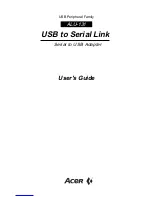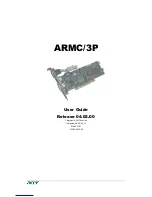
User’s Guide
21020285 D
Chapter 5 Initiator Mode Pass-through Commands
Initiator Pass-through Status Block Format
Page 5 - 15
The unexpected phase encountered can be determined by interpreting the state
of the three signals:. This is described below:
See your SCSI or SCSI-2 specification for more information about SCSI
phases.
Sense Bytes
- When enabled to do so (the IRS bit of the Flags-1 field of the
Pass-through command is not set), the RF3880 adapter automatically responds
to Check Condition status from a device, with a Request Sense command.
The device answers the Request Sense command by returning information
about its condition. This information is called Sense Bytes. Depending on the
peripheral, up to 256 Sense Bytes can be returned in response to the Request
Sense command.
There are three ways that Sense Bytes can be reported to you by the RF3880
via the Sense Bytes fields of the Status Block:
•
The first eight bytes of Sense data returned (this is the default).
•
Up to 32 of the first sequential Sense Bytes.
•
Up to 16 of any of the 256 possible Sense Bytes returned.
You can specify one of these methods, for Sense Bytes to be reported in the
Status Block of Initiator Pass-through commands, by using the Unit Options
or Extended Unit Options Board-control command (See Chapter 7).
If no Check Condition status occurred, or the automatic Request Sense
capability of the adapter is not enabled, the Sense Bytes fields will all be zero.
See page 5 - 4 for more information about how to inhibit the automatic Request
Sense command (using the IRS bit).
Signal
Phase
Direction of Transfer
MSG
C/D
I/O
0
0
0
Data Out
Initiator to Target
0
0
1
Data In
Initiator from Target
0
1
0
Command
Initiator to Target
0
1
1
Status
Initiator from Target
1
0
0
Reserved
—
1
0
1
Reserved
—
1
1
0
Message Out
Initiator to Target
1
1
1
Message In
Initiator from Target
Table 39: Meaning of Status Byte - Unexpected Phase
Summary of Contents for Rimfire 3880
Page 1: ...Rimfire 3880 SCSI Host Bus Adapter User s Guide Ciprico Inc Publication No 21020285 D...
Page 2: ......
Page 4: ...21020285 D User s Guide...
Page 25: ...2 H a r d w a r e E s s e n t i a l s...
Page 42: ...21020285 D User s Guide Chapter 2 Hardware Essentials Page 2 18 Descriptions of Port Usage...
Page 43: ...3 H a r d w a r e I n s t a l l a t i o n...
Page 59: ...4 C o m m a n d O p e r a t i o n...
Page 85: ...5 I n i t i a t o r M o d e P a s s t h r o u g h C o m m a n d s...
Page 103: ...6 T a r g e t M o d e P a s s t h r o u g h C o m m a n d s...
Page 125: ...7 B o a r d c o n t r o l C o m m a n d s...
Page 175: ...8 D e t a i l s o f U s a g e...
Page 193: ...A E r r o r C o d e s...
Page 201: ...B C a b l e s a n d C o n n e c t o r s...
Page 206: ...21020285 D User s Guide Appendix B Cables and Connectors Page B 6 VMEbus Connector Pinouts...
Page 207: ...C S p e c i f i c a t i o n s...
Page 210: ...21020285 D User s Guide Appendix C Specifications Page C 4 Specifications...
Page 211: ...D D e f a u l t s...
Page 216: ...21020285 D User s Guide Appendix D Defaults Page D 6 HardwareDefaults...
Page 217: ...E D e s i g n D i f f e r e n c e s...
Page 229: ......
Page 230: ...21020285 D...















































